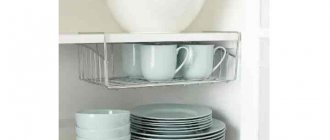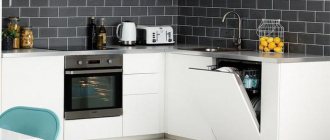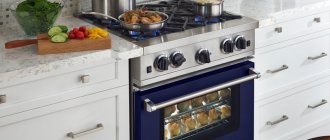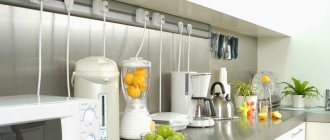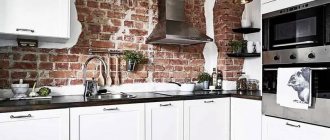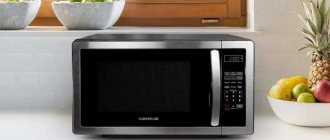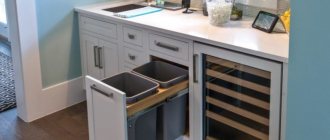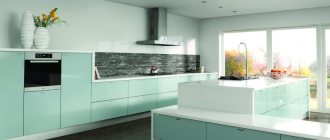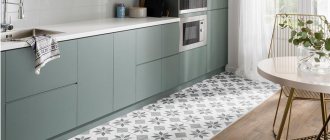So, let's figure out why we are building technology in the first place? Firstly , the correct placement of built-in appliances in the kitchen means cleanliness and silence in the house. Because there are no gaps between the hob and the facades, and there is usually a “treasury” of fat, dried foods and cockroaches. And the equipment itself works much quieter and does not disturb the children’s sleep, because it is tightly closed with facades!
Secondly , built-in appliances are compact, which saves work space in the kitchen. However, to the detriment of the capacity of some household appliances. But for small rooms this is very important, because every centimeter counts.
And thirdly , what is most important is the appearance, where the technology does not destroy the interior, but is hidden behind the facades.
In this article we will talk about how to place built-in equipment safely and functionally, while maintaining a single style of headset!
Standards and rules of placement
Every modern kitchen has a standard set of built-in household appliances : a hob, an oven, an extractor hood, a dishwasher, and less often a refrigerator and a washing machine.
The generally accepted rules for placing sockets for connecting these devices to the electrical network are determined by their design features . There are no regulatory government documents on this matter.
Hob and oven
Electrical sockets for the hob and oven are installed at a height of 20 cm from the floor level , unless otherwise provided in the operating instructions. If the hob is located directly above the oven, then horizontally both sockets are placed at a distance of 30 cm from each other (from the hood axis 15 cm in both directions).
It happens that a conventional stove needs to be built into a kitchen set. In this case, the socket for the stove in the kitchen is installed at the level of any concave place on its back wall . Usually - 15 cm below its hob or at a height of 30 cm from the floor level. From an aesthetic point of view, the connection point of the stove is covered by its body.
Hood
The electrical outlet for the built-in hood is installed inside the cabinet in which it is built . In this case, a hole is cut on the back wall of the cabinet. The plug and cord must not interfere with the operation of the hood or the opening of the cabinet door.
Another option is to locate the outlet above the cabinet . However, this method is unacceptable for a glossy ceiling (the plug will be reflected in it), as well as in the case of a low cabinet location for building in a hood.
Refrigerator and dishwasher
Sockets for the refrigerator and dishwasher are placed at a distance of 30 cm from the floor level . Horizontally, the socket is positioned so that the housing of the household appliance completely covers it (it is better to retreat 10-15 cm from the side edge of the device to the center).
Washing machine
Sometimes you have to place a washing machine in the kitchen, and most often they choose its built-in version. The socket for the washing machine in the kitchen is installed in the same way as for the dishwasher : at a height of 30 cm from the floor level.
Important! Before deciding where to install the outlet, make sure that there is a concave area on the back wall of the household appliance in this place to accommodate the plug (4 cm from the vertical plane).
It is better to purchase built-in equipment in advance or carefully familiarize yourself with its design features in a store or online. The location of the connection point for built-in equipment behind its body is explained by the following reasons :
- easy access to sockets is provided (the household appliance can be easily removed from the niche);
- moving the electrical socket outside the outline of the device makes it difficult to inspect the connection point, adds work to cutting grooves and holes in adjacent cabinets, and can complicate the operation of drawers.
Justification for separate connection
The PUE states that to power household loads whose power exceeds 3.5 kW, a dedicated cable with a separate circuit breaker must be used. This means that for power supply a radial circuit must be implemented.
In our case, the hob often has a power that is higher than one kilowatt. Despite the fact that the oven is a less powerful device, there are models that consume one and a half kilowatts or more.
Therefore, these two devices can be considered as a single whole not only from the point of view of functional purpose: cooking, but also load.
Socket layout
The layout of electrical outlets for household appliances is carried out after the final approval of the kitchen unit layout plan. This can be done in two ways :
- on the floor plan;
- on the developments of vertical projections of the walls.
First, the contours of kitchen cabinets and built-in appliances are outlined . After this, the required distances are set aside and socket installation marks are applied. The purpose of each outlet and its rated current are marked. When the diagram is ready, the drawing is transferred to the wall. This is done using a tape measure, level or plumb line.
Power of household appliances and choice of socket type
Information about the power of a household appliance is located on its body and in the operating instructions . This is a key parameter for choosing the type of electrical outlet. Knowing it, you can calculate the current strength in amperes (A) specifically for this device and choose the right socket for it.
Modern sockets for residential apartments with a voltage of 220 volts are most often designed for a maximum current of 10 or 16 amperes . But there are also higher power ones: 25 or 32 amperes.
The current strength (I) in amperes (A) is determined by the formula: I = P / (U x cosΨ), where :
- P – power of the electrical appliance in watts (W);
- U – voltage in the electrical network in volts (V);
- cosΨ – power factor (approximately equal to 0.95).
Example : the current in the outlet when turning on a 2.2 kW washing machine will be equal to:
I = 2200 W / (220 V x 0.95) = 10.53 A.
Conclusion : in this case you cannot choose a 10 A socket; we accept a larger value - 16 A.
Approximate list of power of the most common built-in kitchen appliances:
- hob – up to 10,000 W;
- oven – up to 4000 W;
- dishwasher – up to 2700 W;
- washing machine – up to 2300 W;
- refrigerator – up to 500 W;
- hood – up to 150 W.
The maximum values are given here; in practice they are much less . Therefore, it is best to choose sockets according to the power of a particular household appliance.
Typically, 25 or 32 A sockets are used for hobs , 16 or 32 A for ovens, 10 A for hoods and refrigerators, and 16 A for other built-in appliances.
Important! For built-in household appliances, electrical sockets for hidden electrical wiring (recessed type) are used, always with protective grounding!
The nuances of electricity distribution in the kitchen
The kitchen space is a room where powerful consumers of electricity are concentrated, so the electrical wiring in the kitchen must be thought out taking into account all the nuances. Among them:
- It is recommended to supply powerful consumers with power through a separate network with a circuit breaker.
- It is better to run the socket and lighting lines separately, with protective disconnecting elements.
- Protective grounding must be installed for sockets. This will not only improve the safety of using kitchen appliances, but also extend their service life.
- To supply electricity to the kitchen, it is better to use several distribution boxes. When using only one, it is recommended to lay a three-core cable line with a cross-section of 4 mm².
Connecting kitchen equipment
Installation
Installation of electrical equipment should only be carried out by a qualified specialist . Laying cables and installing electrical outlets is no exception.
Work procedure:
- Marking on the wall where electrical outlets will be installed according to the approved diagram.
- Wall cutting for cable laying.
- Cabling.
- Installing sockets and connecting them to the power line.
- Checking the functionality of the power supply line.
- Sealing the grooves.
- Finishing the walls and installing the front panels of the sockets.
- Connecting built-in household appliances.
Electrical wiring in the kitchens of residential buildings is laid in a hidden way using a three-core VVG copper cable in a protective sheath . Cable cross-sections are determined based on the total load of all electrical appliances used in the room.
Important! According to the Electrical Installation Rules (PUE), open cable routing (in electrical baseboards or boxes) in kitchens is not allowed!
Connecting a Gorenje electric hob
Before starting work, be sure to study the technical characteristics of the selected model with the connection diagram.
Make sure there are jumpers.
Install jumpers between pins 1 - 2, 4 - 5.
Unscrew the cable clamp, pry it with a screwdriver and remove it.
We connect the wires according to the diagram.
We fix the cable with a clamp.
Next, pump up the hob using the methods described above.
Advantages and disadvantages
Arranging a kitchen space with the help of integrated furniture has a number of positive qualities:
- Built-in headsets are characterized by ergonomics. At the design stage, you can provide for all the nuances and make the furniture as comfortable as possible.
- The final product has an attractive and harmonious appearance. All kitchen cabinets and built-in appliances are matched to the overall design of the room.
- All items are selected based on your own needs and taste preferences. You can make furniture of any kind, color, style and choose the components you want.
- It is possible to manufacture furniture in the traditional classic style and kitchens in modern modernist trends (high-tech, techno, etc.).
- Furniture is produced according to the dimensions of the room, which allows you to make maximum use of the entire area. There are no empty or unused spaces left. The functionality of this layout is much higher.
- All furniture modules are connected to each other with furniture ties, so there are no cracks or joints where debris could get in. Cleaning such furniture is much easier.
The disadvantages include the following:
- Dismantling a built-in kitchen is somewhat difficult. It is not recommended to transport such furniture to other premises, since it is designed and manufactured to individual sizes.
- The cost of such furniture sets is higher than standard sets.
- You can replace faulty fittings or equipment yourself. But performing such work requires some knowledge and skills, so it’s better not to take risks. Only a professional furniture assembler will be able to properly disassemble a built-in kitchen if necessary.
- If there are errors in the layout, it is extremely rarely possible to swap any elements.
Built-in furniture is especially convenient for rooms with a small area. Even a small kitchen in a Khrushchev can be made convenient, ergonomic and comfortable.
Selection of household appliances based on the possibility of existing wiring
Let's go a little deeper into the topic so that everything is clear.
If you are just planning to buy an oven and hob, then it is important to understand whether the existing wiring will withstand the total power of both devices, and not a short-term, but a long-term load.
To do this, you need to find out what cross-section of wires the wires have and based on this, make calculations or use ready-made tables.
To measure the cross-section of the wire, use a caliper. An ordinary ruler will not work, as the measurements will have a large error.
Do the following:
- Disconnect the cable.
- Strip the insulation of one core to at least 1 cm.
- Take measurements using a compass.
Next, use the formula from the school course: S=π×d²÷4.
Where:
- S is the required cross-sectional area.
- D – measured diameter.
- Π = 3.14.
For example, measurements showed a core diameter of 2.4 mm. We carry out the calculation: 3.14x2.42÷4=4.52mm2. The recommended value is from 4 to 6 square millimeters.
In new houses built after 2001, the conductors are usually copper, in old ones they are mainly aluminum.
Further, using the table below, you can find out how much power this cable can withstand.
Fitted kitchen styles
Custom-made kitchens are matched to any style and interior design. The choice depends on the personal preferences of the owners. Each style has certain characteristic individual traits.
The following styles are most often used in kitchen design:
| Classic. | Classic trends never go out of style. This type of furniture is distinguished by reliability and solidity. This style looks better in large rooms, when it is possible to use different decorative elements (carvings, pilasters, columns, cornices). Kitchens with a bar counter or island look impressive. |
| High tech. | It stands out with a lot of metal and glass. The main emphasis in such kitchens with built-in appliances is not on furniture, which is rather a complement to the overall style of the room, but on the design of household appliances. Involves the use of a bright dominant color. |
| Minimalism. | This style direction is characterized by an almost complete absence of decorative details, correct forms, maximum clarity and purity of lines, as well as monochromatic color schemes. Shiny and smooth surfaces, straight and precise shapes, an abundance of lighting fixtures - all this is designed to create the illusion of a large space. The built-in retractable kitchen table will emphasize the laconic design. |
| Japanese style. | A movement akin to minimalism, which involves the use of only natural materials (wood, bamboo, wicker, fabric, etc.), natural lighting and a small amount of decor. |
| Country style. | Predominant light furniture, an abundance of stained glass, and floral patterns are features inherent in the Provence style. The lightness, elegance and sophistication of this design create a special atmosphere of harmony and comfort in the house. |
| Art Deco. | Luxurious and expensive style, using a large number of decorative elements (columns, pilasters, portals, etc.) and a variety of materials (leather, ivory, expensive wood, etc.). A bright and rich color scheme (black, white, purple) with an abundance of gold, silver or bronze finishes is welcome. |
Now the sewer
There are some rules for laying the drain hose. As standard, its length does not exceed 1.5 meters. This length is optimal if the machine is located near the sink, but if it is located at a considerable distance, you will have to lengthen it, and here it is important to know that the maximum permitted length of the drain hose should be 4 meters.
Also take into account how far from the floor the sewerage system will be installed; this measure should not be more than 0.7 meters. When connecting the hose supplied with the washing machine, it is recommended to install an additional siphon under the sink. Now that the most important thing is connected, all that remains is to draw out the cold water. It is not difficult.
Included with the sewer hose is a flexible inlet hose of similar length, to connect which you will need a water tap with a standard three-quarter thread. Remember that the location of the hose should be convenient for subsequent movements or repairs.
Types of kitchens according to materials used
The most popular and common material from which built-in kitchen furniture is made is laminated chipboard (laminated chipboard). The material is obtained by pressing sawdust using phenol-formaldehyde resins as a binding element. Inexpensive and practical, it comes in many colors that imitate stone, wood, leather, etc. Laminate is durable, moisture-resistant and resistant to chemicals.
Kitchen sets made of MDF (finely dispersed fraction) are in demand. The manufacturing technology of MDF boards consists of pressing highly ground sawdust at high temperatures and under high pressure. Synthetic resins do not participate in this, because when heated, the chips release a natural binder - lignin. The material is milled well, allowing products to be given various shapes. As a protective coating, enamel or PVC film is used, which has many types, colors and textures.

